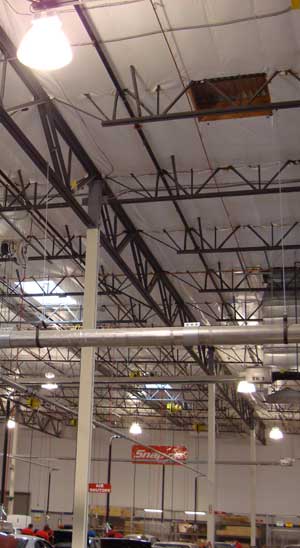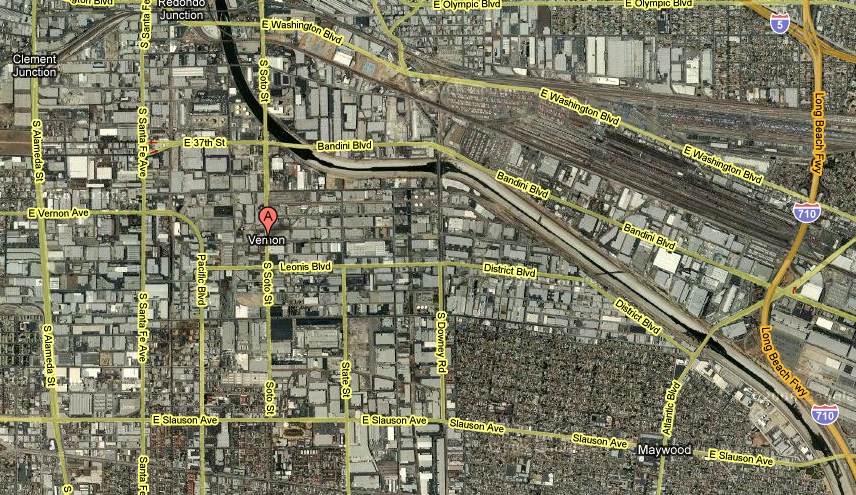When new lamps are installed in industrial warehouse and manufacturing buildings, 4 types of lighting technology are used.
The technology in high intensity discharge (HID) lighting is in some ways similar to fluorescent technology: an arc is established between two electrodes in a gas-filled tube which causes a metallic vapor to produce radiant energy. In this case, however, a combination of factors shifts the wavelength of much of this energy to within the visible range, so light is produced without any phosphors. In addition, the electrodes are only a few inches apart (at opposite ends of a sealed “arc tube”) and the gases in the tube are highly pressurized. This allows the arc to generate extremely high temperatures, causing metallic elements within the gas atmosphere to vaporize and release large amounts of visible radiant energy. There are three main types of HID lamps: mercury vapor, metal halide and sodium. The names refer to the elements that are added to the gases in the arc stream which cause each type to have somewhat different color characteristics and overall lamp efficiency.
Ballasts and Warm-Up Time: Like any gaseous discharge light source, HID lamps have special electrical requirements that must be supplied by a ballast. With HID sources, however, the ballast must be specifically designed for the lamp type and wattage being used. In addition, HID lamps require a warm-up period to achieve full light output. Even a momentary loss of power can cause the system to restrike and have to warm up again—a process that can take several minutes. In applications where constant illumination is important for safety and security, a backup system is often required.
Metal Halide Lamps: Metal halide lamps are among the most energy efficient sources of white light available today. These lamps feature special chemical compounds known as “halides” that produce light in most regions of the spectrum. They offer high efficacy, excellent color rendition, long service life and good lumen maintenance. Because of their numerous advantages, metal halide lamps are used extensively in outdoor applications and in commercial interiors.
Sodium Lamps: High-pressure sodium sources were developed primarily for their energy efficiency. Mercury and sodium vapors in the ceramic arc tube produce a yellow/orange light with extremely high LPW performance and exceptionally long service life (up to 40,000 hours). High-pressure sodium lamps render colors poorly, which tends to limit their use to outdoor and industrial applications where high efficacy and long life are priorities. Since these lamps produce light at only one wavelength in the yellow region of the spectrum, they are used where energy efficiency and long life are the only requirements.
Mercury Vapor Lamps: Mercury vapor lighting is the oldest HID technology. The mercury arc produces a bluish light that renders colors poorly. Therefore, most mercury vapor lamps have a phosphor coating that alters the color temperature and improves color rendering to some extent. Other HID types that offer higher LPW and better color properties have largely superceded the use of this lamp.
LED Lighting: Lighting fixtures using LEDs are the most energy-efficient and versatile solution for lighting your warehouse. Their energy consumption is lower than that of any other light source, yet their Lumen output is comparable or superior.




 The Bureau of Labor Statistics released its latest U.S. Labor Market Report on Friday, covering the U.S. employment situation in December, and the news was depressing. Total nonfarm employment fell by -524,000 jobs in December, and the job losses in October and September were revised down to -584,000 jobs and -423,000 jobs respectively. In percentage terms, employment has declined by -1.12% in the last three months. This was the biggest three-month decline since mid 1980 and before that, the first three months of 1975 (Both years saw severe recessions).
The Bureau of Labor Statistics released its latest U.S. Labor Market Report on Friday, covering the U.S. employment situation in December, and the news was depressing. Total nonfarm employment fell by -524,000 jobs in December, and the job losses in October and September were revised down to -584,000 jobs and -423,000 jobs respectively. In percentage terms, employment has declined by -1.12% in the last three months. This was the biggest three-month decline since mid 1980 and before that, the first three months of 1975 (Both years saw severe recessions).